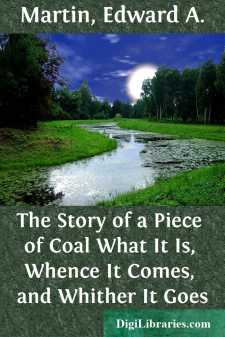Categories
- Antiques & Collectibles 13
- Architecture 36
- Art 48
- Bibles 22
- Biography & Autobiography 813
- Body, Mind & Spirit 142
- Business & Economics 28
- Children's Books 17
- Children's Fiction 14
- Computers 4
- Cooking 94
- Crafts & Hobbies 4
- Drama 346
- Education 46
- Family & Relationships 57
- Fiction 11829
- Games 19
- Gardening 17
- Health & Fitness 34
- History 1377
- House & Home 1
- Humor 147
- Juvenile Fiction 1873
- Juvenile Nonfiction 202
- Language Arts & Disciplines 88
- Law 16
- Literary Collections 686
- Literary Criticism 179
- Mathematics 13
- Medical 41
- Music 40
- Nature 179
- Non-Classifiable 1768
- Performing Arts 7
- Periodicals 1453
- Philosophy 64
- Photography 2
- Poetry 896
- Political Science 203
- Psychology 42
- Reference 154
- Religion 513
- Science 126
- Self-Help 84
- Social Science 81
- Sports & Recreation 34
- Study Aids 3
- Technology & Engineering 59
- Transportation 23
- Travel 463
- True Crime 29
The Story of a Piece of Coal What It Is, Whence It Comes, and Whither It Goes
by: Edward A. Martin
Description:
Excerpt
CHAPTER I.
THE ORIGIN OF COAL AND THE PLANTS OF WHICH IT IS COMPOSED.
From the homely scuttle of coal at the side of the hearth to the gorgeously verdant vegetation of a forest of mammoth trees, might have appeared a somewhat far cry in the eyes of those who lived some fifty years ago. But there are few now who do not know what was the origin of the coal which they use so freely, and which in obedience to their demand has been brought up more than a thousand feet from the bowels of the earth; and, although familiarity has in a sense bred contempt for that which a few shillings will always purchase, in all probability a stray thought does occasionally cross one's mind, giving birth to feelings of a more or less thankful nature that such a store of heat and light was long ago laid up in this earth of ours for our use, when as yet man was not destined to put in an appearance for many, many ages to come. We can scarcely imagine the industrial condition of our country in the absence of so fortunate a supply of coal; and the many good things which are obtained from it, and the uses to which, as we shall see, it can be put, do indeed demand recognition.
Were our present forests uprooted and overthrown, to be covered by sedimentary deposits such as those which cover our coal-seams, the amount of coal which would be thereby formed for use in some future age, would amount to a thickness of perhaps two or three inches at most, and yet, in one coal-field alone, that of Westphalia, the 117 most important seams, if placed one above the other in immediate succession, would amount to no less than 294 feet of coal. From this it is possible to form a faint idea of the enormous growths of vegetation required to form some of our representative coal beds. But the coal is not found in one continuous bed. These numerous seams of coal are interspersed between many thousands of feet of sedimentary deposits, the whole of which form the "coal-measures." Now, each of these seams represents the growth of a forest, and to explain the whole series it is necessary to suppose that between each deposit the land became overwhelmed by the waters of the sea or lake, and after a long subaqueous period, was again raised into dry land, ready to become the birth-place of another forest, which would again beget, under similarly repeated conditions, another seam of coal. Of the conditions necessary to bring these changes about we will speak later on, but this instance is sufficient to show how inadequate the quantity of fuel would be, were we dependent entirely on our own existing forest growths.
However, we will leave for the present the fascinating pursuit of theorising as to the how and wherefore of these vast beds of coal, relegating the geological part of the study of the carboniferous system to a future chapter, where will be found some more detailed account of the position of the coal-seams in the strata which contain them. At present the actual details of the coal itself will demand our attention....


